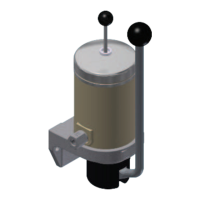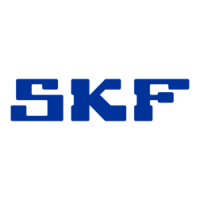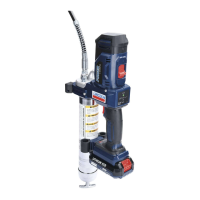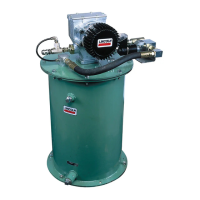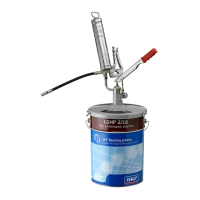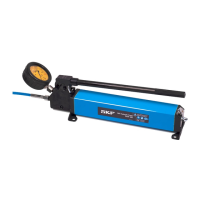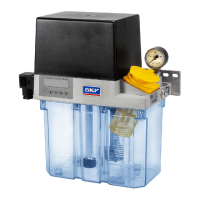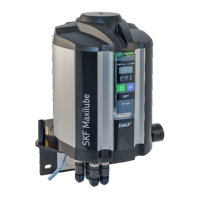Do you have a question about the SKF Lincoln P205 and is the answer not in the manual?
Information on safety and economic viability training courses offered by SKF.
States warranty information is in general terms and conditions.
Lists manufacturer's non-responsibility for damages caused by misuse or unauthorized modifications.
Lists common abbreviations and their meanings and conversion factors.
Owner's responsibility for ensuring personnel read and understand instructions.
Guidelines for safe product usage, operation, and behaviour.
Specifies the product's authorized application within lubrication systems.
Lists prohibited uses outside specified conditions or environments.
Prohibits unauthorized modifications due to safety risks.
Lists activities restricted to manufacturer specialists or authorized personnel.
Prohibits painting plastic parts or seals of the product.
Details directives (EMC, RoHS, LV, PED) related to CE marking.
Lists safety and functional electrical inspections performed before delivery.
Lists additional documents to be observed for operation and setup.
Describes warning labels and rotational direction marking on the product.
Explains information on the type identification plate and data entry.
Confirms product conformity with Eurasian customs union legal provisions.
Defines roles: Operator, Specialist in mechanics, Specialist in electrics.
Requirements for informing external technicians about safety provisions.
Operator must provide suitable PPE for the operation.
Key information to observe during commissioning and operation.
How to perform an emergency stop by interrupting power or using switches.
Comprehensive safety guidelines for handling the product throughout its lifecycle.
Ensures safety devices, connections, and labels are functional and present.
Safety precautions for cleaning, avoiding flammable agents and high-pressure cleaners.
Details potential risks and recommended prevention or remedy measures for each lifecycle phase.
Requirements for lubricants, importance of specified types, and handling precautions.
Guidance on selecting lubricants based on machine design and requirements.
Lists materials that lubricants must generally be compatible with.
Importance of lubricant suitability for ambient temperature and viscosity.
Recommendations for inspecting lubricants after prolonged downtime.
Observes types of solid lubricants like graphite, MoS2, copper, calcium carbonate/hydroxide.
Advisories on using chisel pastes for bearings and system pressure limits.
Serves as protection against contamination and for filling.
Provides air for the reservoir during pump operation and lubricant supply.
Homogenises and smoothens lubricant, improving suction.
Mounts the pump and accommodates elements, fittings, and shafts.
The pump can be equipped with up to 5 pump elements.
Used for filling the pump from the bottom or connecting optional fittings.
Drives the pump; different types are available depending on the version.
Reduces motor speed to the necessary pump speed.
Monitors the filling level in the reservoir via LEDs.
For pumps supplied without a motor, the operator mounts a suitable motor.
Lists operating pressure, number of pump elements, temperature, and protection classes.
Provides detailed specifications for different motor types used with the pump.
Specifies motor speeds required for lubrication grease and oil.
Illustrates the hydraulic circuit of the pump system.
Details blind zone, scanning range, frequency, resolution, and switching states.
Specifies switch point settings for high, pre-low, and low-level indications.
Shows available reservoir variants (XYN/XYNA, XYBU) and sizes.
Specifies torque values for various components like pump elements and sensors.
Explains how to interpret the product's type identification code for selection.
Instructions for checking shipment for damage and completeness upon receipt.
Procedures for cleaning and packing products for return.
Guidelines for dry, dust-free, and protected storage to prevent damage.
Recommends verifying and renewing corrosion protection every 6-12 months.
Specific storage advice for motors, including insulation resistance checks.
Specifies admissible temperature ranges for parts with and without lubricant.
Details conditions for storing parts filled with lubricant based on storage period.
Only qualified personnel should install; pay attention to assembly and safety.
Protect against humidity, dust, vibrations; ensure accessibility.
Ensure sufficient space for maintenance and component attachment.
Instructions for connecting the motor and ultrasonic sensor according to standards.
Step-by-step guide to adjust the output volume of pump element KR.
Procedure to protect each pump element with a pressure control valve.
Installation instructions for lubrication lines for safe and smooth operation.
Instructions for filling the reservoir via various connections.
Checklist for electrical, mechanical connections, and component integrity.
Checklist for unusual noises, leaks, lubricant quality, and lubrication points.
Refers to the chapter on filling with lubricant for refilling procedures.
Use only compatible cleaning agents and rinse thoroughly.
Mark wet areas, keep unauthorized persons away, clean outer surfaces.
Normally not required; contact SKF Customer Service if needed.
Clean the sensor face with a cloth if contaminated.
Inspect and potentially replace pressure relief valves, check valves, and pump elements.
Specifies service life and oil change interval for the gear unit.
The ultrasonic sensor is free of maintenance.
General advice for motor maintenance, including airways, surfaces, and condensation water checks.
Guidelines for replacing or inspecting motor bearings based on load type.
How to measure insulation resistance, safety precautions, and voltage limits.
Checklist for regular visual inspections of the product's components and operation.
Lists possible causes and remedies for a pump that fails to run.
Lists causes and remedies for low or no lubricant supply.
Procedure for checking and replacing pump elements and pressure control valves.
Procedures for temporarily shutting down the system.
Planning and execution of final shutdown and disassembly.
Guidelines for product disposal according to EU and non-EU regulations.
Lists available pump elements with part numbers and gasket information.
Lists available pressure relief valves with part numbers.
Details the closure screw and its function.
Lists ultrasonic sensors for different reservoir versions with part numbers.
Lists available motors with part numbers.
Lists available gear ratios with part numbers.
Lists drive assemblies combining motors and gears with part numbers.
Lists drive assemblies for free shaft ends with part numbers.
Lists available flange seals with part numbers and dimensions.
Lists available reservoir lids with part numbers and features.
Lists reservoir assemblies with part numbers and components included.
Information on safety and economic viability training courses offered by SKF.
States warranty information is in general terms and conditions.
Lists manufacturer's non-responsibility for damages caused by misuse or unauthorized modifications.
Lists common abbreviations and their meanings and conversion factors.
Owner's responsibility for ensuring personnel read and understand instructions.
Guidelines for safe product usage, operation, and behaviour.
Specifies the product's authorized application within lubrication systems.
Lists prohibited uses outside specified conditions or environments.
Prohibits unauthorized modifications due to safety risks.
Lists activities restricted to manufacturer specialists or authorized personnel.
Prohibits painting plastic parts or seals of the product.
Details directives (EMC, RoHS, LV, PED) related to CE marking.
Lists safety and functional electrical inspections performed before delivery.
Lists additional documents to be observed for operation and setup.
Describes warning labels and rotational direction marking on the product.
Explains information on the type identification plate and data entry.
Confirms product conformity with Eurasian customs union legal provisions.
Defines roles: Operator, Specialist in mechanics, Specialist in electrics.
Requirements for informing external technicians about safety provisions.
Operator must provide suitable PPE for the operation.
Key information to observe during commissioning and operation.
How to perform an emergency stop by interrupting power or using switches.
Comprehensive safety guidelines for handling the product throughout its lifecycle.
Ensures safety devices, connections, and labels are functional and present.
Safety precautions for cleaning, avoiding flammable agents and high-pressure cleaners.
Details potential risks and recommended prevention or remedy measures for each lifecycle phase.
Requirements for lubricants, importance of specified types, and handling precautions.
Guidance on selecting lubricants based on machine design and requirements.
Lists materials that lubricants must generally be compatible with.
Importance of lubricant suitability for ambient temperature and viscosity.
Recommendations for inspecting lubricants after prolonged downtime.
Observes types of solid lubricants like graphite, MoS2, copper, calcium carbonate/hydroxide.
Advisories on using chisel pastes for bearings and system pressure limits.
Serves as protection against contamination and for filling.
Provides air for the reservoir during pump operation and lubricant supply.
Homogenises and smoothens lubricant, improving suction.
Mounts the pump and accommodates elements, fittings, and shafts.
The pump can be equipped with up to 5 pump elements.
Used for filling the pump from the bottom or connecting optional fittings.
Drives the pump; different types are available depending on the version.
Reduces motor speed to the necessary pump speed.
Monitors the filling level in the reservoir via LEDs.
For pumps supplied without a motor, the operator mounts a suitable motor.
Lists operating pressure, number of pump elements, temperature, and protection classes.
Provides detailed specifications for different motor types used with the pump.
Specifies motor speeds required for lubrication grease and oil.
Illustrates the hydraulic circuit of the pump system.
Details blind zone, scanning range, frequency, resolution, and switching states.
Specifies switch point settings for high, pre-low, and low-level indications.
Shows available reservoir variants (XYN/XYNA, XYBU) and sizes.
Specifies torque values for various components like pump elements and sensors.
Explains how to interpret the product's type identification code for selection.
Instructions for checking shipment for damage and completeness upon receipt.
Procedures for cleaning and packing products for return.
Guidelines for dry, dust-free, and protected storage to prevent damage.
Recommends verifying and renewing corrosion protection every 6-12 months.
Specific storage advice for motors, including insulation resistance checks.
Specifies admissible temperature ranges for parts with and without lubricant.
Details conditions for storing parts filled with lubricant based on storage period.
Only qualified personnel should install; pay attention to assembly and safety.
Protect against humidity, dust, vibrations; ensure accessibility.
Ensure sufficient space for maintenance and component attachment.
Instructions for connecting the motor and ultrasonic sensor according to standards.
Step-by-step guide to adjust the output volume of pump element KR.
Procedure to protect each pump element with a pressure control valve.
Installation instructions for lubrication lines for safe and smooth operation.
Instructions for filling the reservoir via various connections.
Checklist for electrical, mechanical connections, and component integrity.
Checklist for unusual noises, leaks, lubricant quality, and lubrication points.
Refers to the chapter on filling with lubricant for refilling procedures.
Use only compatible cleaning agents and rinse thoroughly.
Mark wet areas, keep unauthorized persons away, clean outer surfaces.
Normally not required; contact SKF Customer Service if needed.
Clean the sensor face with a cloth if contaminated.
Inspect and potentially replace pressure relief valves, check valves, and pump elements.
Specifies service life and oil change interval for the gear unit.
The ultrasonic sensor is free of maintenance.
General advice for motor maintenance, including airways, surfaces, and condensation water checks.
Guidelines for replacing or inspecting motor bearings based on load type.
How to measure insulation resistance, safety precautions, and voltage limits.
Checklist for regular visual inspections of the product's components and operation.
Lists possible causes and remedies for a pump that fails to run.
Lists causes and remedies for low or no lubricant supply.
Procedure for checking and replacing pump elements and pressure control valves.
Procedures for temporarily shutting down the system.
Planning and execution of final shutdown and disassembly.
Guidelines for product disposal according to EU and non-EU regulations.
Lists available pump elements with part numbers and gasket information.
Lists available pressure relief valves with part numbers.
Details the closure screw and its function.
Lists ultrasonic sensors for different reservoir versions with part numbers.
Lists available motors with part numbers.
Lists available gear ratios with part numbers.
Lists drive assemblies combining motors and gears with part numbers.
Lists drive assemblies for free shaft ends with part numbers.
Lists available flange seals with part numbers and dimensions.
Lists available reservoir lids with part numbers and features.
Lists reservoir assemblies with part numbers and components included.
| Brand | SKF |
|---|---|
| Model | Lincoln P205 |
| Category | Water Pump |
| Language | English |


